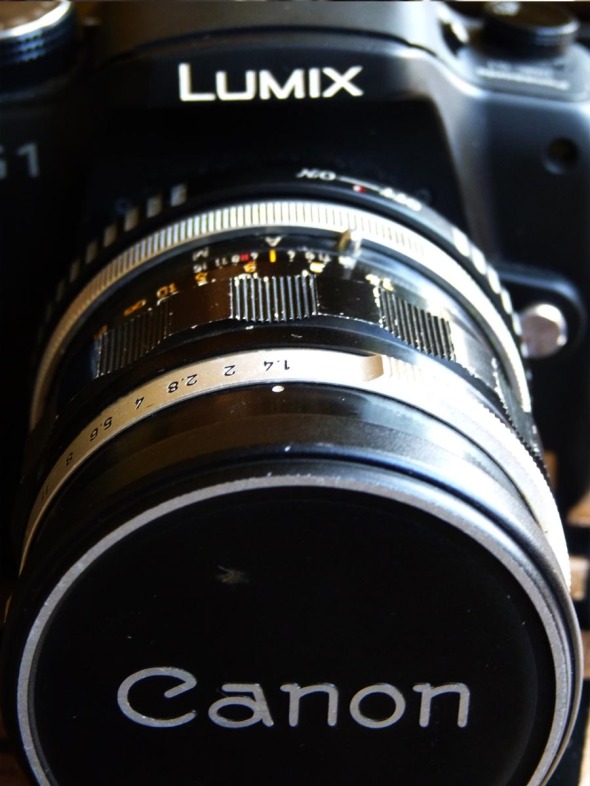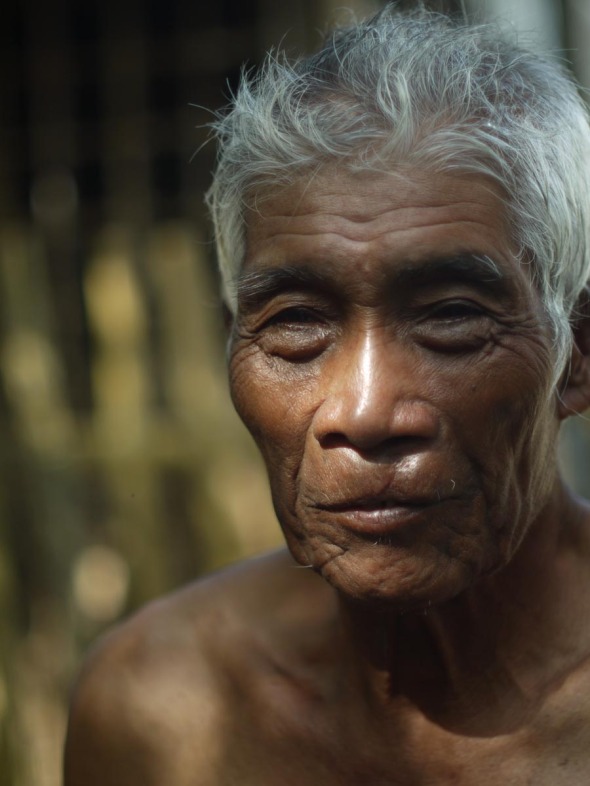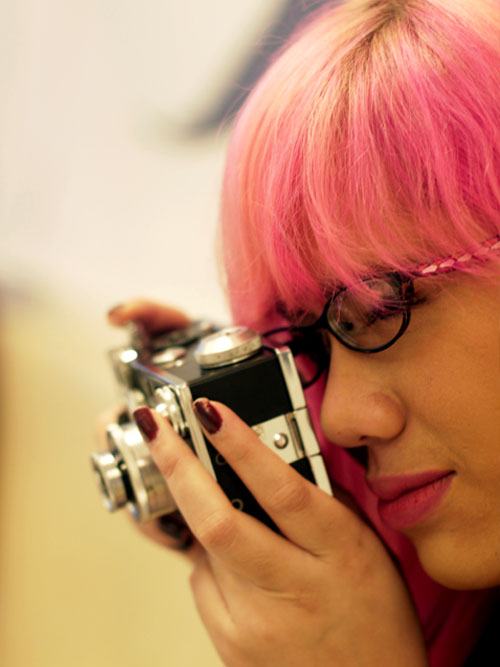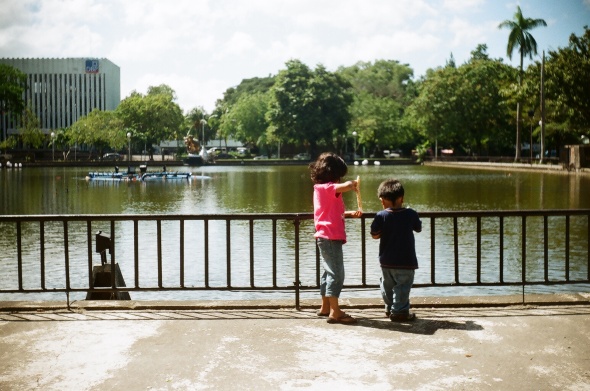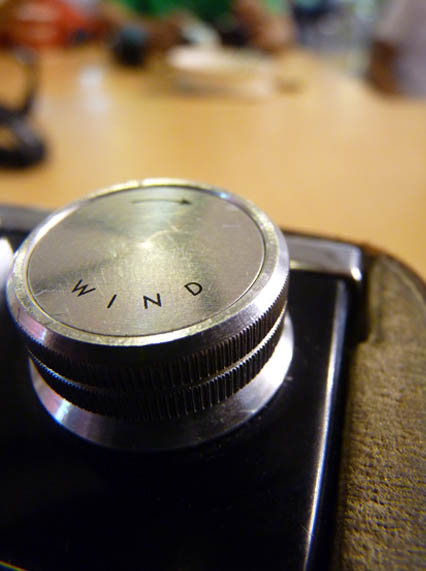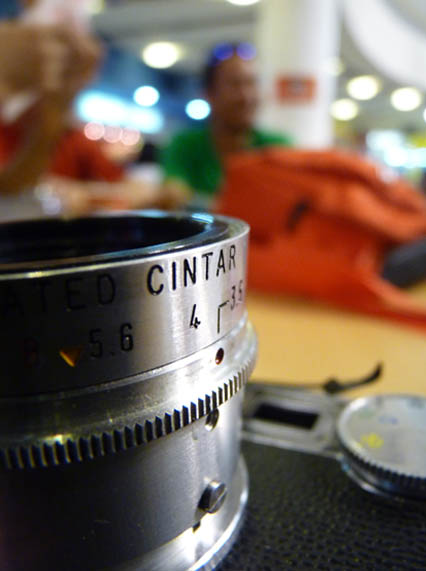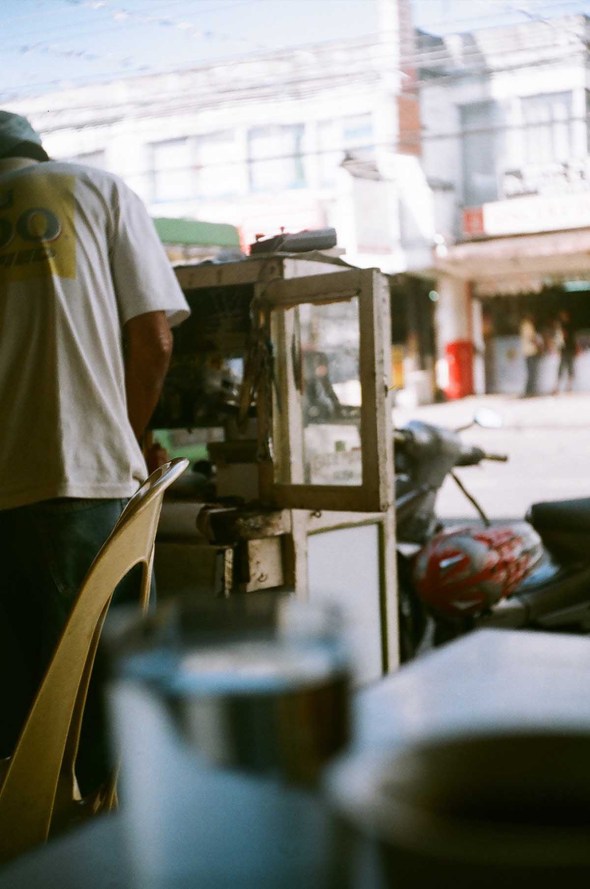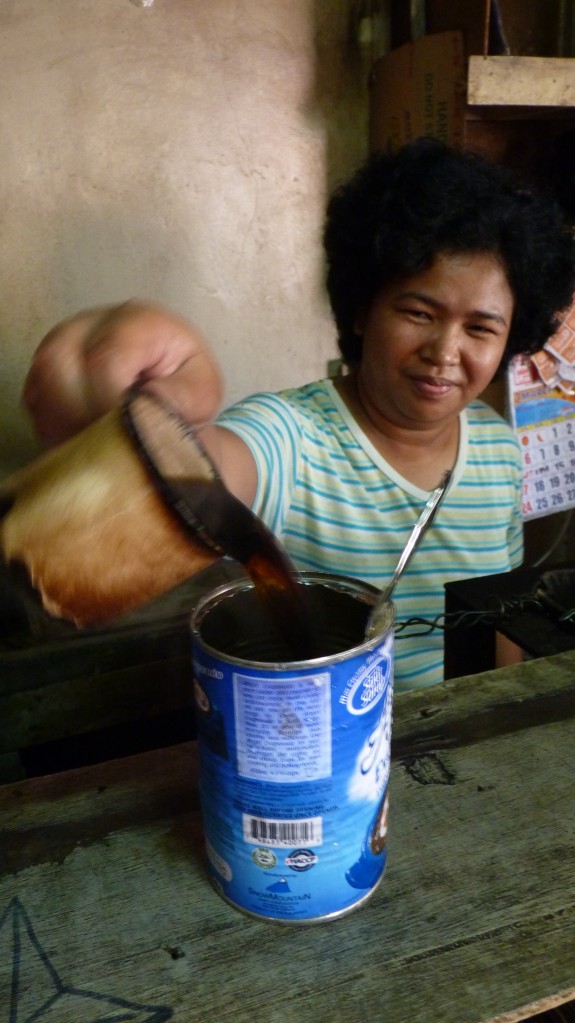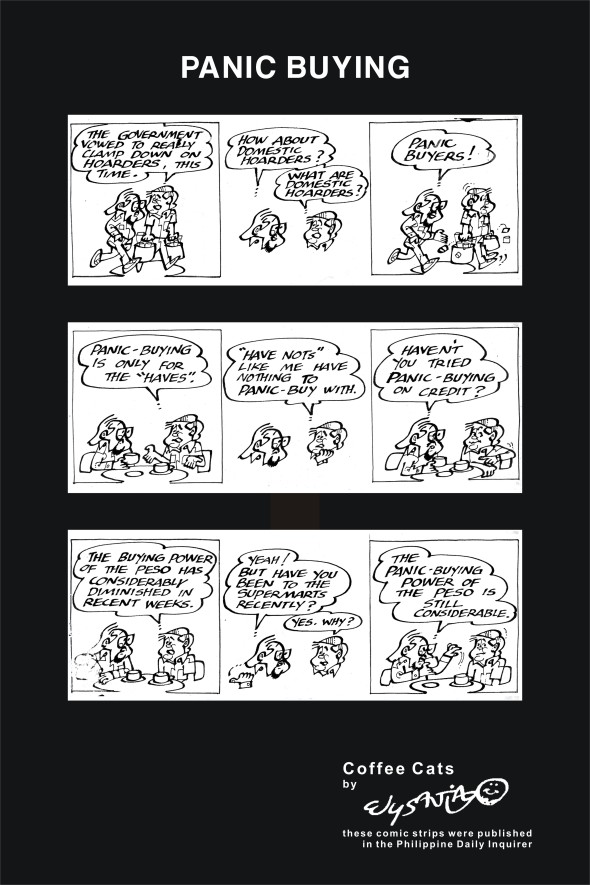Shooting with Film in the Digital Age: Argus C3 goes to the Market
The Bacolod City Central Market is one of my favorite places to shoot.
Lumix G1 and Canon FL 50mm f1.4. Wide-eyed :)
The camera I shoot with most often nowadays is a Panasonic Lumix G1 micro 4/3 camera fitted with a Canon FL 50mm f 1.4 manual lens.
That metal lens cap with the old Canon typography exudes an old world charm. The body of the FL is scratched and dinged but the glass inside is still good.
Here are a few of the best shots I took with this combo.
Lolo Cito of Sitio Roma, Silay City.
Lola Lolita of Sitio Roma, Silay City. At 82 years old, she still forages for seashells to sell.
Joe in his workshop.
Nick at New Gerce Cafe
Keisha and the Argus C3
Shooting with Film in the Digital Age: Argus C3 shoots a keeper on a Sunny Day
I have shot a lot of photos with a myriad selection of cameras. So far I have used the following: Nikon D70, D70s, Lumix FZ35, Holga 120 CFN, Lumix G1 with Canon FL 50mm f1.4, and the Argus C3. A lot of shots, a lot of favorites. This single photograph that I’m posting is just a testament that I was at the perfect place at the perfect time. I had the Argus C3 (1952) that day loaded with a Fuji ASA 100 film and with the correct settings, I composed the frame, turned the knobs of the rangefinder, and clicked the shutter. (The Argus metallic clang is a joy to listen to.)
After having the films processed, I had this as a keeper 🙂
Shooting with Film in the Digital Age… Another Argus C3 Episode
Here are a few more shots from “The Brick.” I don’t have a light meter so most of the shots are done instinctively. Sun up = speed up.
There’s a certain magic in film grain that is absent from digital photography. Sniff too much of it and you get hooked.
Argus C3 shot by Lumix FZ35 in macro mode
Here’s the Argus C3 Rangefinder up close. Dials and dials. Lovely old camera.
Shooting with Film in the Digital Age
I borrowed an Argus C3 rangefinder camera from a friend and tried my hand in shooting with it. This was a totally different experience compared to shooting with the Holga. Shooting with a rangefinder, especially with the Argus C3, require a lot of patience and research. I enjoy taking photographs with my digital Lumix but shooting with an old mechanical tool gives me a different kind of high. The metallic clink and clang of the Argus shutter, the pain of focusing, the metal knobs and gears, the quirky way of advancing the film, all these add up to a different kind of photography experience.
But then a camera is just a camera. Its main purpose is to capture images and I always believe that the image does not have to tell the viewer about the equipment used to achieve it. Here are a few samples of my successful experiment (after a first failure) with the camera also known as the “Brick.”
Go Fishing
One of the things I want to do is to become an “apprentice” in a fishing boat. I want to experience life at sea. I want to feel helpless in the vastness of the waters that surround me. I want to help pull the nets to haul the catch of the day. And of course, I want to have meals of the freshly caught seafood.
If this wish becomes a possibility, then this will be my vessel of choice. Colorful, rusting, rustic, creaky, full of stories. Do you know anyone operating a fishing boat like this?
Photo taken at the little sandy beach at BREDCO port Bacolod City.
Coffee in a Can
Coffee stalls in markets use evaporated milk in cans instead of cream or fresh milk. Cans are then reused as take-away containers for coffee instead of paper, plastic and styrofoam cups.
Remembering Ely Santiago,1941-1993. First of a Series
Ely Santiago was an artist who honed his craft through diligent experimentation and mastery of different media and materials. He was known for his acrylic paintings where he utilized self made etching materials which he used to supplement his brushes in creating texture and detail in his renditions of bahay kubo houses, and portraits of ordinary folk. He was also a caricaturist known to capture the essence of his subject in a few masterful strokes with whatever material he has on hand – cigarette foil, table napkins, walls, etc. His commercial caricatures of persons and families done in watercolor adorned homes in the city. He experimented with terracotta and made sculptures ranging from the whimsical to serious portraiture. His wit and humor was evident in his cartoons and comic strips, most notably “Coffee Cats” which was published in the Philippine Daily Inquirer.
He was an active member and former president of the Arts Association of Bacolod, an organization he loved, fought for and was devoted to.
He was one of the founders and was responsible for giving the name “MassKara” to the festival that made Bacolod a known tourist destination.
Lechons and Lapidas
After a memorable gastronomic weekend highlighted by the Marketmanila Lechon feast, I bade goodbye to Cebu with a box full of chopped up lechon and other goodies to bring home. On the trip back to the airport we passed through a cemetery and I took a picture of this scene from the window of the taxi. A man and his display of grave markers. Life and death. Lechons and Lapidas.
A Blog Post Before the World Ends on May 21, 2011
The world will not end on May 21 because of a little unresolved issue. An unresolved issue about certain signs. You see these signs along roadsides from bustling urban sidewalks to sleepy towns and even in lonely stretches of highways. These signs harbor a promise of salvation and a solution to allow you to go on with life and reach the ultimate destination. But then which of these signs speak the truth? They all, in one way or another, provide solutions but which one is truthfully spelled?
Vulcaning, Volkit, Vulcanizeng, Vulcaning, Vulcate while you wait, and of course the thirteen-letter version of the spelling in the photo above. VULLCANIYZING. I asked my good friend G about the provenance of the word and he told me that the proper term for this process of salvation of worn out tires (and not the tired and worn out) is Vulcanization and not the previous spellings I wrote. But Vulcanization is not the word in the signs out there??? Therefore it is wrong! How can you even think of debating a painted wooden sign nailed on a tree? The world will not end until every sign by the roadside says VULLCANIYZING.
(The sign above was shot from the open window of a jampacked non airconditioned bus while picking up more passengers in the cave-rich city of Mabinay, Negros Oriental)
The Holga Chronicles III
This is from my 4th roll of film. I still made the mistake of shooting with the lens cap attached. I still attempted to shoot an ASA 100 film with an approximate 1/100 sec. shutter speed in the shade with disastrous results. The last shots from the roll are still amazing and I finally had one with the Holga “Light Streak.” I used an expired Fujifilm YKL for this series.
Streetside Barbecue
From the vantage point of the back seat of a jeepney, I take out my camera, make some adjustments, point, shoot, return camera inside the bag. The shot was not sharp. It was in fact a blur. A pleasant, smoky, light splattered blur.
Holga Hiatus
Busy. Rainy. I didn’t have time to go out on the streets and shoot.
Among the things I did for this Holga madness is a shot list and exposure chart on a piece of index card. This acts as a guide and is necessary to minimize film wastage. A 36 shot roll of film can provide 20 to 24 exposures with spacing in between images. My next experiment would be to achieve slightly overlapping images soon. I hate to do the math yet.
Let me leave you with this garden shot. This shot is blurred an terribly exposed. But that’s what a Holga can do to you.
The Holga Chronicles II
The Holga is not just a simple plastic camera. It is a drug. Addicting and mildly hallucinogenic. The advent of digital photography has freed most of us from the additional cost of buying and processing film and having it printed. Film. Almost obsolete little canisters of celluloid mixed with enough chemicals that make images permanent when exposed to light passing through a camera’s lens. One shot, one kill. One wrong shutter speed and aperture combination, one frame wasted.
I just loaded and processed my third film roll. The first roll was a wasteful right of passage, an initiation by the film gods. The second had decent results. The third had the story and emotion I was looking for. I’m on a roll. I’ll be buying more rolls. Kodak and Fuji would be happy. Here are some of the stories caught on film by my third roll.
Araneta Street. Downtown Area of Bacolod City.
Sharpening saws along the sidewalk.
The tabloid reader
The Holga Chronicles
A friend gave me a Holga 120 CFN camera. It shoots film. Yes that and more. It is difficult, almost impossible to find 120 film in my city so with the help of a lot of googling I modified the innards of the Holga to shoot the more available 35 mm film. What inspired me to start using this toy are the resulting images when using a 35mm film with a 120 Holga.
I love the rough and surprising results of using film. The Holga 120 is not an SLR so what you see in it’s little viewfinder is not what you get. What you see is what you might get. Among the quirks of using this toy is the absence of a film advance lever. To move the film to the next frame with spacing requires an exact number of “clicks” that diminish as you progress. I shoot with a pad and a pen to make a shot list to guide me with how many clicks would be necessary to move to the next frame.
Shooting with film is a challenge in this digital era. Challenging and fun.
The city at night
As night falls and the stores close for the night and people rush for home, a small portion of the sidewalk along Gonzaga street is about to start its day. Tables, benches and plastic chairs are set and trays of food on display. What was a busy sidewalk in front of a bakery, a pawnshop and a shoe store is now an instant alfresco diner.
DECOMPOSITION: composing the decomposing
Fallen leaves, rain water and weathered concrete gave me this palette of colors and textures to work on. The leaves tell me to get out more often, open my eyes wider than usual and shoot more. The rain puddle agrees.
Taxi Shrines
The new increase in flagdown and meter rates found me gravitating towards old and beat-up taxis when I need a ride. So far most of the old cabs still run the old meter rates. They also have dismal air conditioning, tinny sound systems, and some with spoons as door latches. And they also smell of old smoke, old sweat and everything old and stale. All these ambiance for a fare difference of twenty pesos.
As I sit and half-listen to a mumbling driver I took shots of his taxi shrine. Rosaries hanging from the rear view mirror, statuettes glued on the dashboard, the dog whose head sways, the metal cat who waves, a baby shoe, buddha, whatnot, usually comprise the embellishments of a taxi shrine.
A Man’s Shrine is a Man’s Shrine.
Across a Chinese school is a wall with a “shrine” of a different kind. It is chaotic and festooned with bits and pieces of found objects with the dominant appearance of bamboo crosses and crayon scribbled messages. I suspect that this is a work of progress with the contrast of fresh Christmas decor against the faded poster of an actor turned senator.
This is Installation Art at its most innocent. No pretense, no forced strokes, no price tag.
The message is simple and clear. “Paghidait” or Peace. Moon, Sun, Star and “Anak.” And Happy Frying Pan.
I wonder as I wander Hong Kong’s streets
I enjoy the anonymity of being a stranger in a different place. There is a satisfaction in being able to wander aimlessly in streets unknown. Being in the streets brings me close enough to see and touch the details and also close enough too to smell the scents ranging from the pleasant to the putrid.
There is no global language. In the absence of a common tongue gestures suffice. In a little noodle shop across the hotel I point at a display of noodles and beef brisket and that was what I was served. Pictures speak a thousand words. Pictures of food in a menu speak a thousand more.
Bangkok Bling
I saw this interesting character sitting along the sidewalk. This was shot through the window of a taxicab. Bangkok was hot and humid. Perfect weather to be shirtless.
Charms, amulets, rings on most fingers and a fistful of Bahts adorn this man. There is something mystical about this man and his embellishments. Incantations and inscriptions. Cures and curses. If I was not in a taxi I could have taken more pictures of him or asked for one of his rings.
Bangkok. Tesserae madness.
The Grand Palace is described in most travel advice sites in the web as a must see sight in Bangkok.
Most of the structures in this complex are covered in mosaic. Walls, roofs, spires and domes are embellished with little pieces of assorted tesserae. Tile, ceramic, glass, and bits of stone are laid out to form intricate swirls, florals and patterns. I squint and focus on the details. Strange thoughts start buzzing in my head. I started to think of the craftsmen who worked the mosaics. What were on their minds? Did they sing work songs as they glued little pieces? Where they paid well for their labor?
Not much is written about the craftsmen who made these amazing mosaics. Unseen magical hands with no names.







